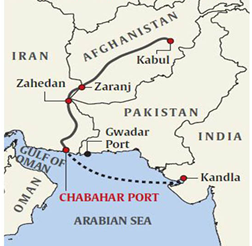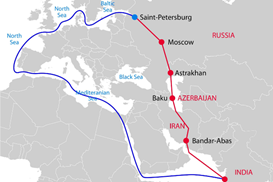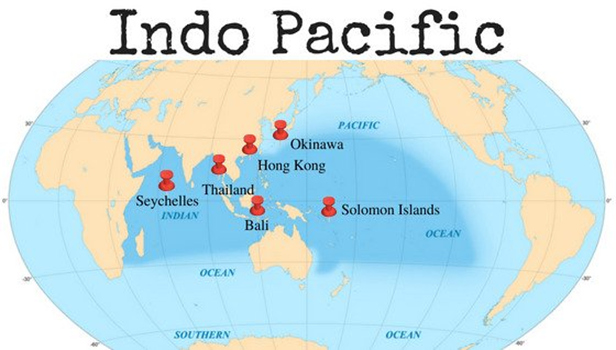India observes Chabahar Day
- Posted By
10Pointer
- Categories
World Affairs
- Published
1st Aug, 2022
-
-
Context
The Ministry of Ports, Shipping and Waterways (MoPSW), in collaboration with India Ports Global, commemorated 'Chabahar Day' in Mumbai to commemorate the Chabahar - Link to INSTC - Connecting Central Asian Markets.
- The International North-South Transport Corridor (INSTC) is India's goal and endeavour to shorten the time it takes for EXIM goods to reach Russia, Europe, and Central Asian markets.
-
Background
- As we enter the new millennium, the central government is making a concerted effort to interact with our "extended neighbourhood."
- The Look-East-turned-Act-East, Link West, and other policies demonstrate this.
- Central Asia is an essential part of India’s extended neighbourhood that it aims to reconnect through Connect Central Asia strategy, which was unveiled in 2012.
- After the inauguration of a new administration, Central Asia as a theatre attracted new attention.
- The complete participation of India in the Shanghai Cooperation Organization (SCO), Prime Minister Modi's historic tour to five Central Asian nations, and other examples demonstrate this.
- The International North-South Transport Corridor, or INSTC, receives special attention in India-Central Asia ties.

-
Analysis
How significant is Chabahar Port for India?
- India sees the port as critical to its interests and wants to develop it to compete with Pakistan's Gwadar port, which was built with Chinese assistance.
- The port will allow India to circumvent Pakistan and use sea and land routes to transfer products to Afghanistan and Central Asia.
- Chabahar Port in Iran is located on the Persian Gulf and will assist India in expanding its marine commerce in the region.
- It also gives the opportunity for Indian firms to expand and develop their presence in the area.
- It is approximately 76 nautical miles (less than 150 kilometres) west of the Pakistani port of Gwadar, which China is developing. As a result, it is perfect for observing Chinese or Pakistani military action outside of Gwadar.
- The port will cut the cost and time required to transport Indian goods by one-third.
- Iran's existing road network can connect Chabahar to Zaranje in Afghanistan, roughly 883 kilometres from the port.
- India's Zaranj-Delaram road, completed in 2009, may offer access to Afghanistan's Garland Highway, enabling road connectivity to four important cities in Afghanistan: Herat, Kandahar, Kabul, and Mazar-e-Sharif.
|
About the Chabahar Port:
- Chabahar Port is located on the Gulf of Oman in southern Iran.
- It is Iran's sole port with direct access to the sea.
- It is situated on Iran's energy-rich southern coast in the province of Sistan-Baluchistan.
- Chabahar port is seen as the doorway to golden chances for India, Iran, and Afghanistan to trade with Central Asian countries.
|
-
What is INSTC?
- The International North-South Transport Corridor (INSTC) project was initiated in 2000 in Petersburg by India, Iran, and Russia and has since expanded to include ten other Central and West Asian countries:
- Azerbaijan, Armenia, Kazakhstan, Kyrgyzstan, Tajikistan, Turkey, Ukraine, Belarus, Oman, Syria, and Bulgaria as observers.
- Pakistan, Turkmenistan, and Afghanistan are not signatories to the INSTC but are interested in using the corridor.
- It envisions a 7,200-kilometer-long multi-modal network of ship, rail, and road lines for cargo transportation, with the goal of lowering transportation costs between India and Russia by roughly 30% and cutting transit time from 40 days to less than half.
- The route mostly transports merchandise from India, Iran, Azerbaijan, and Russia.

Significance of INSTC:
- Increased connectivity: By easing access to additional markets, it has the potential to convert the economy of nations along the corridor into specialised manufacturing, logistics, and transportation centres.
- A less expensive and quicker alternative: The recent blockade of the Suez Canal, which cost the world economy $9 billion, has strengthened the INSTC's hopeful perspective as a less expensive and faster alternative multimodal transportation route.
- Managing the demand deficit: The flow of products and services will certainly enhance information sharing systems throughout the corridor, which has the potential to reverse member nations' current demand deficits.
- Can Counter China's Belt and Road Initiative: Because of China's ambitious One Belt, One Road Initiative, INSTC has economic and strategic value for India. As a result, the proposed INSTC commerce corridor might assist India in protecting its interests in Central Asia and beyond.
- Humanitarian Aid: It will aid in the provision of better emergency humanitarian aid.
-
How will this benefit India?
- Export Opportunities: INSTC connects India to Central Asia, and Russia, and has the potential to grow to the Baltic, Nordic, and Arctic areas, significantly expanding the scope of commerce.
- Economic involvement: It gives India a quicker trade route to Iran, Russia, and Europe, allowing for more economic interaction.
- Given the constraints in the straight route through Pakistan, this opens a permanent alternate path for India to trade with Afghanistan and Central Asia.
- INSTC might be the key to India's 'Connect Central Asia' agenda if seen in accordance with the Ashgabat Agreement.
|
Ashgabat Agreement
- The Ashgabat Agreement is a multimodal transportation agreement signed by Kazakhstan, Uzbekistan, Turkmenistan, Iran, India, Pakistan, and Oman.
- Its goal is to establish an international transportation and transit corridor that will facilitate the transfer of products between Central Asia and the Persian Gulf.
|
India’s other strategic location in the Indo-Pacific:

-
What are the persistent constraints?
- INSTC continues to lack a robust institutional structure for dealing with operational challenges in the field.
- Customs processes and documentation continue to be problematic.
- Concerns about the financing of required infrastructure.
- The route has a low level of containerization.
- There are no standard restrictions for crossing borders among member states.
- Rail tariffs are higher than road tariffs for movements from Bandar Abbas.
- There aren't enough automobiles.
- A security risk posed by Islamic rebels to the east and west of the road, as well as the concomitant challenge of high insurance rates.
-
What measures are required?
- Future Potential: The establishment of industrial parks and special economic zones (SEZs) to grow certain industries such as pharmaceuticals and agriculture will add commercial and real value to this connectivity corridor in the future.
- Cross-border e-commerce: As internet connection improves throughout INSTC member nations and the corridor area as a whole, cross-border e-commerce is one of the main industries that will benefit the most.
- Revolutionary Development: Through economic growth, this connection endeavour, together with its underlying commercial benefits, has the potential to bring about transformative development in the region.


